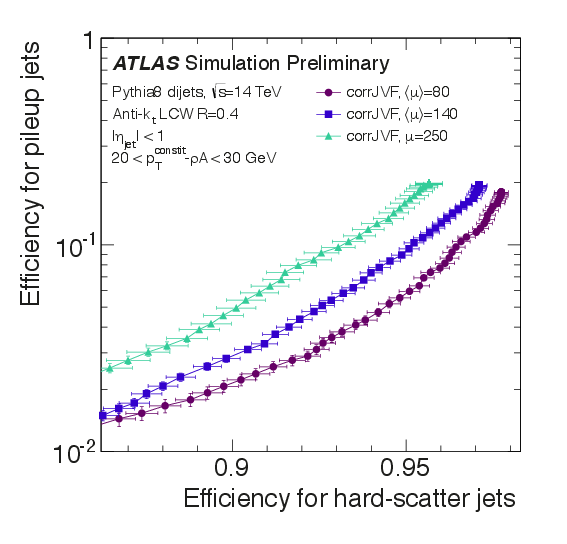
Pileup suppression at very high luminosity
Plots
| Pileup jet fake-rate vs. hard-scatter jet efficiency curve for various RpT [1] (solid) and corrJVF [1] (open) cut values in QCD di-jet events for jets with 20 < pT < 30 GeV and |η| < 2.4. Hard-scatter jets are matched within Delta R < 0.3 to a truth jet with pT > 10 GeV, whereas pileup jets are required to have a minimal ∆R > 0.6 from any truth jet with pT > 4 GeV. The mean number of pileup interactions per event is about 21, corresponding to 2012 LHC conditions. The magenta curves was obtained using a minimal track pT of 0.5 GeV, whereas for the blue curves a pT threshold of 1 GeV was used. The track selection criteria are taken from Ref. [1]. The increased minimal track pT results in a decreased highest efficiency working point, due to an increase of jets with no associated tracks from the hard-scatter primary vertex. For efficiency working points below ~95%, no significant difference in performance is observed, indicating that track-based pileup jet suppression can successfully be exploited even with minimal track pT of 1 GeV. |  [pdf] |
| The mean number of jets (Nj) with pileup-corrected pT > 20 GeV and |η| < 1 per event as a function of the number of reconstructed primary vertices. The magenta and blue curves represent QCD dijet events generated with an average of 80 and 140 interactions per bunch crossing. For the green and black curves, dijet events with exactly 250 or 300 interactions per bunch crossing were used. A significant increase in the jet multiplicity is observed (solid markers). For the curves with open markers, tracking information was used to suppress pileup jets, by imposing the same RpT > 0.1 criterion to all four samples, where a nearly constant jet multiplicity is observed. |  [pdf] |
| Pileup jet fake-rate vs. hard-scatter jet efficiency curve for corrJVF [1] in QCD di-jet events with an average number of interactions per bunch crossing mu = 80, 140 and 250. The curves are shown for jets with area-corrected transverse momenta between 20 and 30 GeV and |η| < 1. The discrimination between hard-scatter and pileup jets decreases with increasing pileup, mainly due to a decreasing jet energy resolution and an increase in the number of pileup vertices that are merged with the hard-scatter primary vertex. |  [pdf] |
| Pileup jet fake-rate vs. hard-scatter jet efficiency curve for corrJVF [1] in QCD di-jet events with an average number of interactions per bunch crossing mu = 80, 140 and 250. The curves are shown for jets with area-corrected transverse momenta between 30 and 60 GeV and |η| < 1. The discrimination between hard-scatter and pileup jets decreases with increasing pileup, mainly due to a decreasing jet energy resolution and an increase in the number of pileup vertices that are merged with the hard-scatter primary vertex. |  [pdf] |
References
Major updates:
-- DavidLopezMateos - 18 Oct 2014 Responsible: DavidLopezMateos
Subject: public
Topic revision: r3 - 2014-10-20 - DavidLopezMateos
or Ideas, requests, problems regarding TWiki? use Discourse or Send feedback
